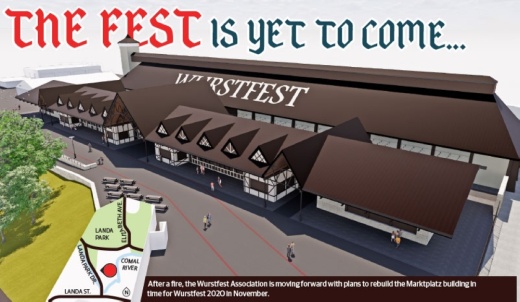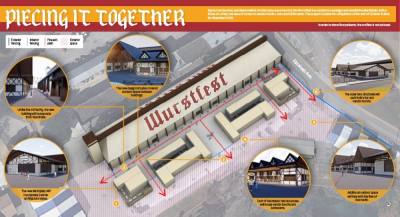On the evening of Nov. 14, just four days after the conclusion of Wurstfest 2019, the first of two fires broke out in the historic Martkplatz building on the Wurstfest grounds.
According to reports released by the city of New Braunfels, the first fire was reported at 7:15 p.m. and was contained to a single booth after spreading to the roof and attic area.
The second fire was reported at approximately 6 a.m. on Nov. 15 and is believed to have been a flare-up from the previous fire.
As a result of the fires, the Marktplatz suffered significant damage and was later determined to be structurally unsound, Wurstfest Executive Director Suzanne Herbelin said. Wursthalle also experienced smoke and heat damage.
The Martkplatz was home to vendor booths operated by a variety of local nonprofits and organizations since the early 1970s, though the tradition of serving food and selling goods next to the main Wursthalle dated to the festival’s beginning in 1960, Herbelin said.
Vendors such as Sherry Bettersworth, director of New Braunfels Performing Arts, relied heavily on proceeds from the festival to fund the nonprofit theater company.
“Being there is not only profitable, but it is also fun for us being part of the community,” Bettersworth said.
Like many vendors, New Braunfels Performing Arts lost all of its equipment in the fire before it could be removed after the festival as planned.
“We were all taken aback,” Bettersworth said. “To put the equipment back into our booth is going to cost our organization about $30,000.”
Bettersworth’s insurance policy for the festival had ended shortly after Wurstfest, and she, like many other vendors, now faces the cost of replacing her materials for the upcoming festival.
In losing the Marktplatz, many nonprofits and organizations in New Braunfels face losing a vital stream of revenue, Bettersworth said.
After the fire, work immediately began on developing a plan to rebuild the Martkplatz as quickly as possible in preparation for the festival’s 60th anniversary later this year.
“After the shock wore off, it was go time,” Herbelin said. “The fire took place on a Friday morning, and by Monday night we had a board meeting and already had a committee.”
Constructing a plan to rebuild
The rebuild committee consists of seven members who represent different groups within the Wurstfest Association, such as the safety and security team and the concessions committee, according to Ian Taylor, chair of the rebuild committee and CEO of New Braunfels Utilities.
“There’s so much expertise on the committee that is going into the design process,” Taylor said. “I may be the chair, but there’s a whole bunch of people working on this within the festival.”
Once the rebuild committee was formed, its members began working to find a way to rebuild the Marktplatz in time for Wurstfest and in a way that would best serve guests and vendors.
“The schedule was one of the primary drivers behind putting the plan together,” Taylor said. “So much of what we’re doing in the project is driven by the needs of the concessionaires.”
T.S. Byrne Co., also known as Byrne Construction Services, which recently constructed Das Rec, was selected to oversee the rebuild and hired San Antonio-based MarmonMok Architecture to handle the design of the project.
In order to complete the Marktplatz before the 60th anniversary, scheduled for Nov. 6-15, the Wurstfest Association and Byrne agreed to a design-build proposal with a much shorter timeline than traditional construction projects.
“Design-build is the preferred method for something at this type of scale,” said Byrne Senior Project Manager Michael McCall. “You build it and design it at the same time.”
According to McCall, design-build construction allows the owner of a property to work closely with a construction company to design and approve individual elements over the course of a project’s construction.
This differs from traditional construction methods that require the entire design to be complete and finalized before beginning a bidding process and construction.
“We’re starting it knowing that we’ve got a concept and we know what we need to do, and it’s going to get refined before we finish,” said Tony Battle, president of Byrne Construction Services’ South Texas office.
The remains of the Marktplatz were completely removed in January; Byrne’s schematics were approved in mid-February; and construction on the foundation and structure has begun.
“Because this is a design-build, we’re not going through the whole design process and then starting to build,” Herbelin said. “Our goal is to be as close to finished as we possibly can [by Wurstfest 2020].”
Incorporating traditional design
As the committee planned the new building, members stressed the importance of maintaining the traditional feel of the festival while incorporating upgrades and improvements.
One the key changes will be that the Marktplatz will no longer be connected to Wursthalle and will consist of four buildings linked by a single roof with covered breezeways.
The changes were made in an effort to improve crowd flow and provide easier access to vendors and restrooms.
“When we looked at the actual design of the facility, some of the key things we looked at were improvements to the flow and lines,” Taylor said. “Retaining that look and feel of being inside a German village while at the same time providing a safe and efficient experience for the guests and the concessionaires.”
Over the years, the Marktplatz continually adapted to suit the needs of vendors and rising numbers of tourists attending the festival.
Wurstfest averages 40,000 visitors each day during the 10 days it is open, and lines for vendor booths often filled the Marktplatz.
“It wasn’t a place you wanted to go in and feel part of or hang out and have a true Wurstfest experience,” Battle said. “With the way we have developed the flow for folks to progress through that space, we have tried to eliminate the long lines that would build up in areas.”
Concessionaires were included in discussions regarding the design of vendor booths, which will all be built by Byrne in order to ensure that each booth is efficient and convenient, McCall said.
The project, which will cost the association approximately $10 million, is expected to be completed on Oct. 30, and McCall said some vendors will likely be allowed to enter the facility in September to begin setting up their booths.
Committee members and vendors are hopeful that construction will be completed on schedule and that the upgrades and improvements will smoothly incorporate the traditional German character of the festival.
“There’s multi-generations that have enjoyed the festival,” Herbelin said. “It’s a place where people come back to gather to repeat the fun they had at one point.”







